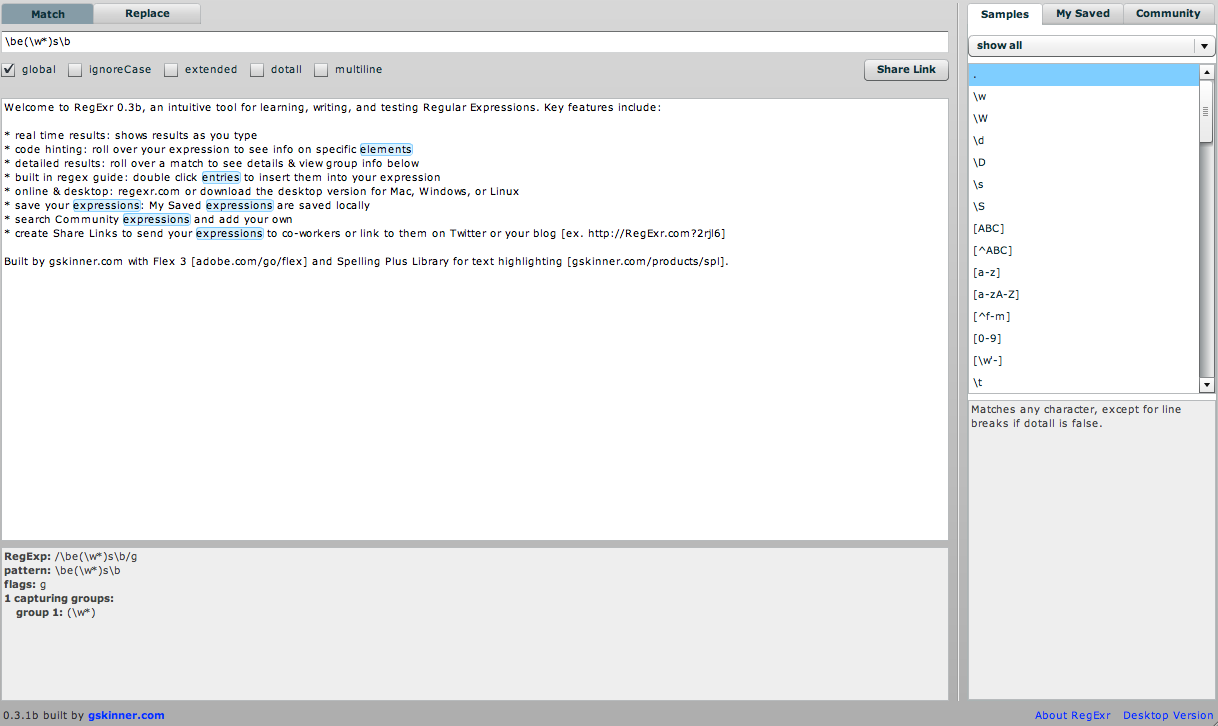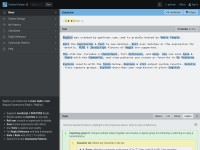- RegExr is looking to solve this problem. It is a free online regular expression builder that will show you the results of your regular expression in real-time. I’ll be using this all of the time now, and it would have definitely been a great tool to have when I was trying to learn the ropes.
- RegExr Desktop I saw in a youtube video that looked clean and simply. On the site currently, looks confusing, cluttered and heavy. – Tony Barganski Nov 21 '19 at 11:06.
Tableau 9.0 added regular expressions to the lineup of Tableau functions. If, like me, your reaction to hearing this news was, “Awesome!”—and by “awesome” I mean “what the heck is RegEx?”—then this blog post is for you!
Regex Tester is a tool to learn, build, & testRegular Expressions (RegEx / RegExp). Results update in real-timeas you type. Roll overa match or expression for details. Save& shareexpressions with others. The RegExr is a great online tool. It lets you put in regular expressions and it shows you what matches in the input text. This is great, but on occasion, I had to work in an environment that did not have an Internet connection. I also had a few ideas on what else I would like for this to do, so I created this Windows desktop tool.
Xkcd.com on regular expressions.
Let’s say you’re like I was. Regular expressions, or regex, isn’t part of our vocabulary. So what is regular expressions? As the comic above indicates, it’s a syntax for searching specific patterns in text, such as an address, URL, or a hex value.
Why you should care about regex
What if you’re working with less-than-perfect data? Mark Fraser discovered his dataset recorded UK postcodes in a nonstandard manner. He used regex to parse out the first portion of the postal code as that is the granularity that Tableau can map.
What if you’re looking at web traffic for links like this: website.com/domain/orderpage.html?productcat=shoes&brand=nike&shoenumber=12345&color=blue and you want to be able to do analysis based on pulling out the product category, brand, shoe number, or color? That’s exactly what Chris Smith needed, and with regex, the solution became much simpler than the string parsing ELSEIF & FIND solution.
Here’s a closer look. The regex /[0-9]{3}-[0-9]{3}-[0-9]{4}/ matches a phone number written in the format ###-###-####. If we want to match a phone number written in the format (###) ###-####, or with periods instead of dashes, or with an extension, or international formats, it’s all possible with a more complicated bit of regex.
How to get started with regex
What kind of strings can regex find? Here’s a list of common regex broken down and explained. I always work best with examples, and these eight regular expressions helped me solidify my understanding in a concrete way.
If you want to learn regex, I recommend this quick start guide. It defines regex as “a pattern describing a certain amount of text,” and goes into the basics at a nice high level. Once you have an overview, jump in a bit deeper. Learn Regex the Hard Way walks through the basic elements of regex step by step, slowly adding a framework and offering suggested exercises.


This brings us to perhaps the most important resource I can suggest, the simulator. RegExr is a phenomenal tool to learn, build, and test regex. With syntax highlighting, mouse-over explanations, real-time visual results, a powerful navigation for examples, a cheat sheet, and a detailed reference library, this is THE tool.
Going beyond the basics
Once you have the basics down, it’s always good to have a resource for the nitty-gritty details. Tableau’s Online Help references ICU’s regex documentation as the official syntax guide for Tableau Data Extracts. Your data source may have a different syntax if you have a live connection. I always like to have multiple resources, so I also checked out the Python regex documentation (though make sure the behavior matches ICU’s, or your specific data source).
Now that we have all these great resources for writing regex, how do we use it in Tableau itself? Tableau supports the following:
- REGEXP_REPLACE(string, pattern, replacement): Returns a copy of the given string where the regular expression pattern is replaced by the replacement string.
- REGEXP_MATCH(string, pattern): Returns true if a substring matches the regex pattern.
- REGEXP_EXTRACT(string, pattern): Returns the portion of the string matching the regular expression pattern.
- REGEXP_EXTRACT_NTH(string, pattern, index): Returns the portion of the string that matches the regular expression pattern. The substring is matched to the nth capturing group, where n is the given index.
Tableau Zen Master Mark Jackson has a great blog post on regex, and gives this example of using REGEXP_EXTRACT to pull out dosage information from medical data:
Regexr Desktop
I took some Airbnb data from Portland and parsed out the bed/bath information from the listings:
Want to see what else is out there? The Regex Library lets you search existing regex patterns, leveraging the community’s knowledge so you don’t have to reinvent the wheel.
What regex resources do you use? Share in the comments below.
After several months of hard work, we’re excited to announce our latest collaboration with Google, Canonical, and the Flutter Team, it’s a cross-platform app called Flokk!

What is it?
Flokk is a Google Contacts Manager, targeting Desktop, that allows you to integrate the Twitter and GitHub activity of your friends and contacts.
Regex Desktop Application
Flokk was built using the latest master branch of Flutter, and targets Linux, macOS, and Windows (with Web-Support thrown in as a bonus!). We spent a lot of time trying to make it feel like a native Desktop App and are extremely happy with the results. In the end performance was great across all the desktop platforms and rendering was extremely consistent. Flutter Desktop really looks like it could be poised for great things.
We worked closely with the Flutter team throughout the project to identify issues and develop workarounds. We will be posting more in the next couple of weeks about the architecture we used, challenges we faced, and some of the specific solutions we came up with.
In the meantime you can check out the code right now! The entire project is open-sourced on GitHub at https://github.com/gskinnerTeam/flokk. We’re excited to see what the community does with this project, and encourage you to clone or fork the repository and jump into the code.
Additionally we’ve posted builds for all operating system and web:
Gskinner Regex Desktop
- macOS: https://flokk.app/macos/Flokk_Contacts_v1.0.1.dmg
- Windows: https://flokk.app/windows/Flokk_Contacts_v1.0.1.zip
- Linux: https://snapcraft.io/flokk-contacts
- Web: https://flokk.app/

The current build is in a “production ready” state, but there were still a number of loose ends and features we were hoping to add, including a better narrow-mode menu and animated side-menu. In the coming weeks and months, we’ll be posting additional updates, and logging issues in Git for the community to potentially look at.

